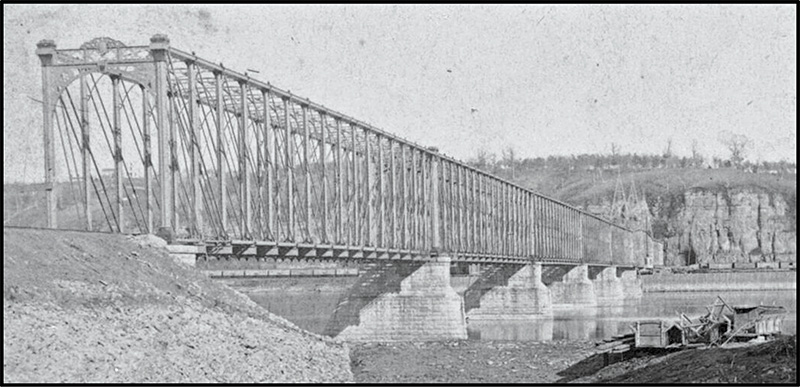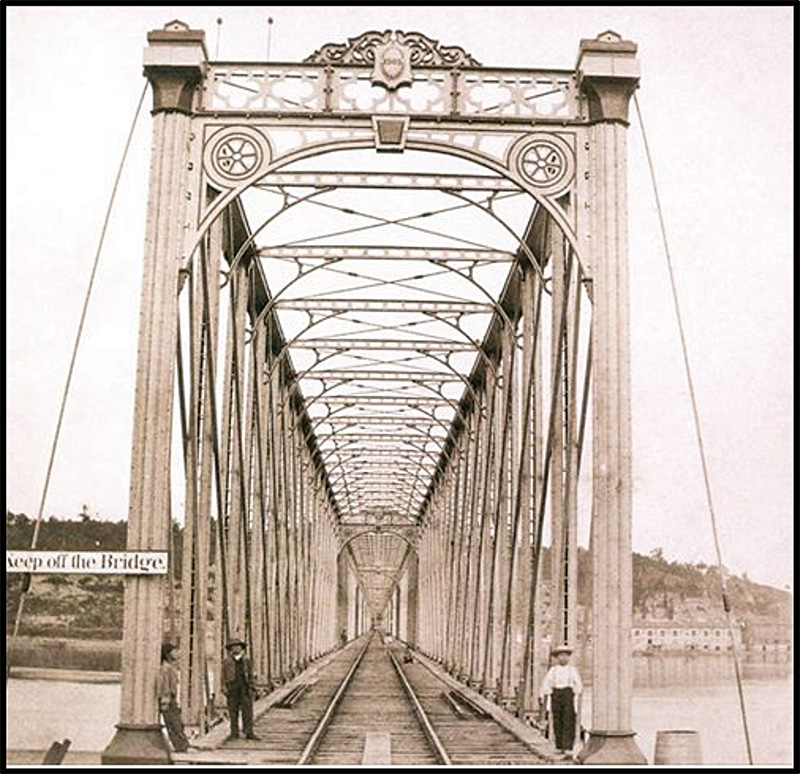The Dubuque and Pacific Railroad began construction on a 29-mile line extending from Dubuque to Dyersville, Iowa in 1857 followed by another 49-mile section to Jessup by 1860. It was purchased by the Dubuque and Sioux City Railroad which extended the line to Cedar Falls, Iowa. The Illinois Central was formed on February 10, 1851 as one of the first land grant railroads and was to run northerly from Cairo at the southwestern tip of Illinois northerly to Chicago and then westerly to Freeport and on to Dunleith, Illinois for a distance of 453 miles. It arrived in Dunleith in 1866. It leased the Dubuque and Sioux City Railroad line in 1867 to extend its line into Iowa.
Congress on July 25, 1866 authorized the bridge as one of eight bridges on the Mississippi and one on the Ohio River. Its requirements were the same as the Quincy Bridge (Structure May 2023) It could either be a low-level bridge with a swing or a high-level bridge. If it was a low level bridge it was to have a “pivot draw-bridge, with a draw over the main channel of the river, at an accessible and navigable point, and with spans of not less than one hundred and sixty feet in length in the clear on each side of the central or pivot pier of the draw, and the next adjoining spans to the draw shall not be less than two hundred and fifty feet; and said spans shall not be less than thirty feet above low-water mark, and not less than ten above extreme high-water mark.” If a high-level bridge it “shall not be of less elevation, in any case, than fifty feet above extreme high-water mark as understood at the point of location, to the bottom chord of the bridge; nor shall the spans of said bridge be less than two hundred and fifty feet in length, and the piers of said bridge shall be parallel with the current of the river; and the main span shall be over the main channel of the river, and not less than three hundred feet in length.”
Section 9 of the Act stated,
And be it further enacted, That a bridge may be constructed and maintained across the Mississippi River, between Dunleith in the state of Illinois, and Dubuque, in the State of Iowa, with the consent of said States previously given or hereafter acquired, with the same privileges, upon the same terms, and under the same restrictions as are contained in this act for the construction of a bridge at Quincy, Illinois.

Illinois approved the bridge on February 14, 1867 and Iowa approved a corporation known as the Dunleith and Dubuque Bridge Company for the purposes of constructing a railroad bridge across the Mississippi river from the city of Dubuque, Iowa, to the city then known as Dunleith, in the state of Illinois on June 3, 1867. In addition to the bridge it required a 980′ long tunnel at Dunleith.
In December 1867 R. B. Nason, the Chief Engineer, sent a Notice to Contractors stating,
The superstructure will be entirely of iron, the draw of all wrought iron, and the remainder of the bridge of all wrought iron except the top chord, which may be of cast iron. Proposals will be received on Post’s, Pratt’s, Bollman’s, Linville and Piper, or any other approved plan of superstructure, with some slight modifications. No single bid will be received for the whole work. But they must be separate for the superstructure, for masonry, foundations, and protection to draw pier and for the work connecting West end of bridge with the Dubuque and Sioux City Railroad.
It is of interest that on their stock certificate they had an image of the Rock Island Bollman Swing span, thinking at the time that their swing span would be similar.

The American Railroad Journal reported of the bids,
The Iron Railroad Bridge across the Mississippi River at Dubuque, Iowa, has been let to the Keystone Bridge Company of Pittsburgh, Penn. All of the prominent bridge builders submitted plans and estimates and the competition was quite spirited, several of the bids being within a trifle of each other; but after careful consideration, the “Linville & Piper” patent truss [really a Whipple double intersection] which has given such perfect satisfaction upon the Pennsylvania, Steubenville, and other leading lines where it has been used, was adopted. The entire bridge is to consist of a draw or “pivot” span of 360 feet, 2 spans adjacent thereto of 250 feet each, and 4 spans of 225 feet–in all 1,760 feet. The contracting parties at first decided to select the plan submitted by the Keystone Bridge Company, in which the top chord was composed of cast iron, but subsequent investigation of the superior merits of their entire wrought iron truss bridge, embracing their patent swelled wrought iron posts, upset weldless chord links, and all of their more recent improvements, induced them to incur the additional expense and contract for the latter.
Andrew Carnegie was the Keystone representative that urged the adoption of an all wrought iron bridge arguing, “In the case of the wrought-iron chord, the bridge would probably only bend; in the case of the cast-iron, it would certainly break and down would come the bridge.” All of the posts were Keystone sections and the top chord of latticed wrought iron channels. Jacob Hayes Linville of the Keystone Bridge Company designed and built the bridge on a modification of the Whipple double intersection truss. There were eight bids and Keystone’s, while not the lowest, was awarded the contract on January 13, 1868 for $275,000. The foundations were let to Reynolds, Saulpaugh & Co. for $242,000. The same firm won the contract for 2,400′ trestle on the Iowa side for $52,000.
Starting on the Iowa end the bridge had four spans of 225′, one span of 250′, a swing span of 360′ (with two clear openings of 160′), and one span of 250′. All of the top chords were straight except the swing span which was curved. The iron portion of the bridge was approached by a 2,400′ wooden trestle on the west end and on the Dunleith side by an 835′ long tunnel. The bridge overall would have a length of 1,760′.
The bridge, the first of all wrought iron, across the Mississippi was tested on December 22 but due to cold and wind the results were questionable and the test repeated on December 30, 1868 with only a 1 5/8-inch deflection under a weight of five locomotives weighing 245 tons. The bridge was officially opened on December 22, 1868, one month ahead of schedule, for freight and passenger traffic. It was replaced in 1900.
